SCOTLAND-4
(Last updated 2/5/05)
Edinburgh:
from West Princes Street Garden, looking past the Ross Fountain
towards Castle Rock, topped by Edinburgh Castle (left); the rock
is known to have been inhabited since the Bronze Age, about 1000
BC. Between the West and East Gardens at the foot of the Mound,
a crowd gayhers in front of the Royal Scottish Academy (right;
designed by Playfair) to attend an outdoor performance of the
Edinburgh Festival; the Bank of Scotland (1870, by David Bryce)
dominates the skyline at left center

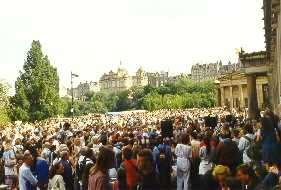 A view of the Royal Mile from the East
Garden (left), with the Assembly Hall of the Church of Scotland
and the spire of Tolbooth St. Johns Church at the center. Floral
Clock (right; the oldest in the world) at the Princes Street entrance
to the East Garden
A view of the Royal Mile from the East
Garden (left), with the Assembly Hall of the Church of Scotland
and the spire of Tolbooth St. Johns Church at the center. Floral
Clock (right; the oldest in the world) at the Princes Street entrance
to the East Garden
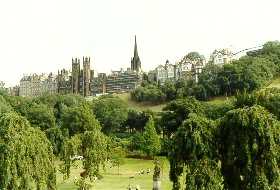
 On Princes Street, the 200-ft spire
of the Scott Monument (1840; left), containing 64 statuettes of
his characters; marble statue (right) of Scott and his dog Maida
(1844; by Sir John Steell), which occupies the center of the monument
On Princes Street, the 200-ft spire
of the Scott Monument (1840; left), containing 64 statuettes of
his characters; marble statue (right) of Scott and his dog Maida
(1844; by Sir John Steell), which occupies the center of the monument

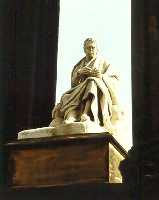 Calton Hill, a 350 ft high rock outcrop
in the city center: from left, the Martyr's Monument, an obelisk
commemorating five political reformers (of the 1790's) transported
for sedition, the Governor's House (part of the old municipal
prison), the Old (1792) and City (1818) Observatories, the 102-ft
high Nelson Monument (1816 - built to commemorate his victory
at Trafalgar), containing a time ball that is dropped in conjunction
with the One o'Clock Gun at the Castle, and just peeking over
the trees at far right, the National Monument, designed by Henry
Playfair in 1816 as a memorial to the fallen in the Napoleonic
Wars, begun in 1822, but never completed after funds ran out.
Calton Hill, a 350 ft high rock outcrop
in the city center: from left, the Martyr's Monument, an obelisk
commemorating five political reformers (of the 1790's) transported
for sedition, the Governor's House (part of the old municipal
prison), the Old (1792) and City (1818) Observatories, the 102-ft
high Nelson Monument (1816 - built to commemorate his victory
at Trafalgar), containing a time ball that is dropped in conjunction
with the One o'Clock Gun at the Castle, and just peeking over
the trees at far right, the National Monument, designed by Henry
Playfair in 1816 as a memorial to the fallen in the Napoleonic
Wars, begun in 1822, but never completed after funds ran out.
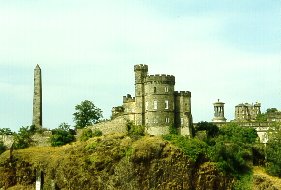
 Onto the Royal Mile, heading up the
High Street section towards the Castle past the Children's Museum
(left) from Netherbow Port; Lawnmarket section of the Royal Mile
(left center); street vendor serving refreshments (right center);
St. Giles Cathedral, High Kirk of Edinburgh (right)
Onto the Royal Mile, heading up the
High Street section towards the Castle past the Children's Museum
(left) from Netherbow Port; Lawnmarket section of the Royal Mile
(left center); street vendor serving refreshments (right center);
St. Giles Cathedral, High Kirk of Edinburgh (right)
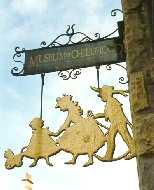
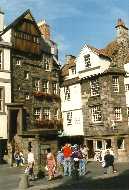
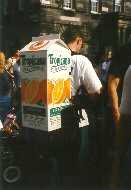
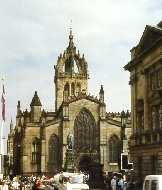 Actors from one of the groups in the
Festival Fringe advertising their performances (left); the Castlehill
section of the Royal Mile, with Tolbooth St. Johns Church (center)
and, across the road, the Outlook Tower, with the Camera Obscura
(1853) at its top
Actors from one of the groups in the
Festival Fringe advertising their performances (left); the Castlehill
section of the Royal Mile, with Tolbooth St. Johns Church (center)
and, across the road, the Outlook Tower, with the Camera Obscura
(1853) at its top
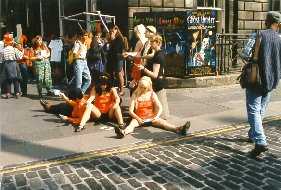
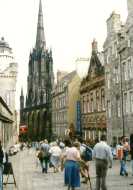
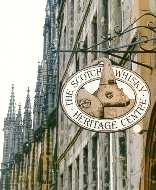 Map (left) of Edinburgh Castle, showing
the spiral rise of the buildings from the Esplanade entrance at
the lower right; the Castle Esplanade, site of the Edinburgh Military
Tattoo, centerpiece of the 3-week long Edinburgh Festival, held
in August
Map (left) of Edinburgh Castle, showing
the spiral rise of the buildings from the Esplanade entrance at
the lower right; the Castle Esplanade, site of the Edinburgh Military
Tattoo, centerpiece of the 3-week long Edinburgh Festival, held
in August
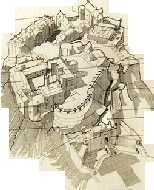
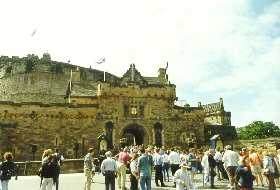 The Portcullis Gate (1574-77; left),
built after the seige of 1571-3 to serve as the main gateway into
the Castle; Foog's Gate, built during the reign of King Charles
II (late 17th c) as the main entrance to the Citadel
The Portcullis Gate (1574-77; left),
built after the seige of 1571-3 to serve as the main gateway into
the Castle; Foog's Gate, built during the reign of King Charles
II (late 17th c) as the main entrance to the Citadel
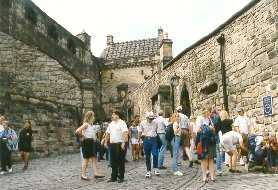
 Approaching the high point of the spiral,
the oldest parts of the Castle, with just a glimpse of the back
of St. Margaret's, at far left (right)
Approaching the high point of the spiral,
the oldest parts of the Castle, with just a glimpse of the back
of St. Margaret's, at far left (right)
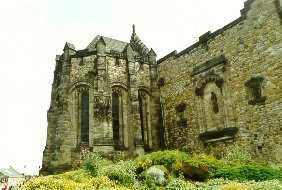
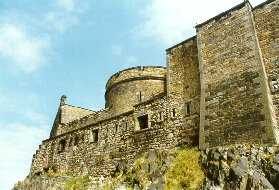 At the very top, the oldest building
in the Castle and in the city, St. Margaret's Chapel (1070-1090,
Norman style; left), is still in use by members of the castle
garrison for weddings; Margaret (center), a Saxon princess, was
the wife of King Malcolm III. Mons Meg, also called 'the Muckle
Murderer,' a 15th c. bombard that could throw a stone cannonball
a mile and a half, presented to King James II for use against
the English
At the very top, the oldest building
in the Castle and in the city, St. Margaret's Chapel (1070-1090,
Norman style; left), is still in use by members of the castle
garrison for weddings; Margaret (center), a Saxon princess, was
the wife of King Malcolm III. Mons Meg, also called 'the Muckle
Murderer,' a 15th c. bombard that could throw a stone cannonball
a mile and a half, presented to King James II for use against
the English
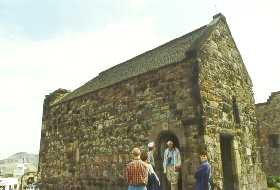
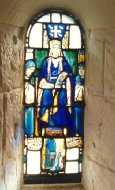
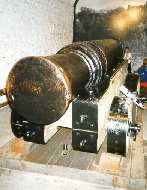 Overviews of the city from the ramparts
of the Castle: the Georgian New Town, laid out by James Craig
in 1766 (left); New Town gives way to the modern city, with the
Scott Memorial at center left, the Nelson Monument on Calton Hill
at center in the distance, and the spire of Tolbooth St. Johns
Church in Old Town on the right, with the Firth of Forth on the
horizon
Overviews of the city from the ramparts
of the Castle: the Georgian New Town, laid out by James Craig
in 1766 (left); New Town gives way to the modern city, with the
Scott Memorial at center left, the Nelson Monument on Calton Hill
at center in the distance, and the spire of Tolbooth St. Johns
Church in Old Town on the right, with the Firth of Forth on the
horizon
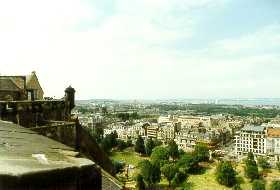
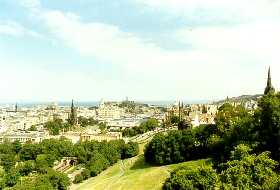 South of Edinburgh into the Scottish
Borders area and the valley of the Tweed River, Melrose Abbey
(left), originally founded by King David I in 1131, rebuilt in
1385 after it was destroyed in a raid by Richard II; in 1996,
archaeologists excavating the grounds (right) discovered a casket
containing a smaller, conical leaden box purportedly holding the
heart of Robert the Bruce, supposedly buried at Melrose by David
II (Bruce's son) in 1329
South of Edinburgh into the Scottish
Borders area and the valley of the Tweed River, Melrose Abbey
(left), originally founded by King David I in 1131, rebuilt in
1385 after it was destroyed in a raid by Richard II; in 1996,
archaeologists excavating the grounds (right) discovered a casket
containing a smaller, conical leaden box purportedly holding the
heart of Robert the Bruce, supposedly buried at Melrose by David
II (Bruce's son) in 1329

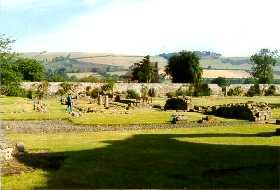 Even further south, Jedburgh Abbey,
also founded by David I (in 1138), destroyed by Henry VIII in
the "Rough Wooing"
Even further south, Jedburgh Abbey,
also founded by David I (in 1138), destroyed by Henry VIII in
the "Rough Wooing"
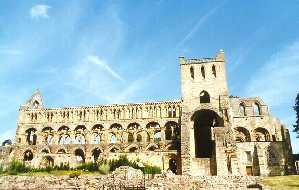
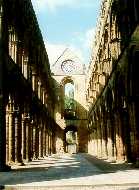
 Go to Scotland-1
| Go to Scotland-2
| Go
to Scotland-3
Return to Home Page
You are visitor: 00
since 1/10/99
Interesting links:
Go to Scotland-1
| Go to Scotland-2
| Go
to Scotland-3
Return to Home Page
You are visitor: 00
since 1/10/99
Interesting links:
































